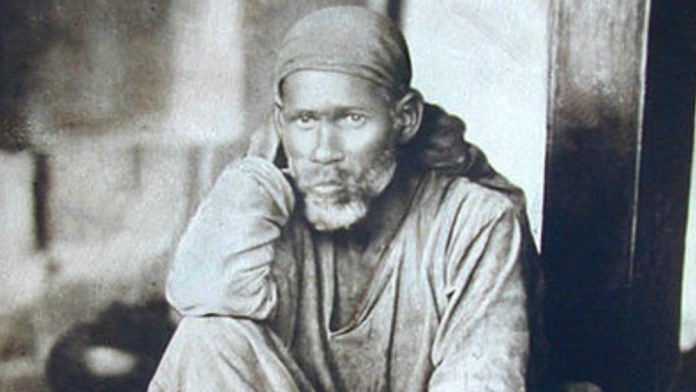When he came to Shirdi, Sai was first found sitting under a neem tree going through hard penance, regardless of heat and cold. At that time he sported long hair (reaching down to the small of his back) and wore a green kafni. His head was covered with an ochre-coloured topi worn over a skull cap. He carried a chillum and a matchbox. His age is believed to be between sixteen and thirty. At times, Shirdi Sai would dress in attire that gave him the look of a wrestler.
Barefooted, he moved in the desolate thickets and jungles around Shirdi in a God-intoxicated state. He sat under a neem or a babul tree for meditation whenever and wherever it pleased him. After his advent in Shirdi in the first half of the year 1872, he was discovered by Baijabai, the mother of Tatya Kote Patil.
After a short stay of maybe two to three months, he vanished. He subsequently reappeared with the marriage party of Chand Bhai Patil of village Dhupkheda and finally settled in Shirdi towards the latter part of 1872.
It may be mentioned that certain physical exercises like yoga and wrestling are practiced by certain sects of Hinduism and Islam. Incidentally, the young Sai, who practiced wrestling, got into a wrestling bout with a local wrestler named Mohiddin Tamboli and lost. This defeat made him realize the futility of focusing solely on developing the human body, and he quit not only wrestling but also the wrestler’s attire.
Instead, he donned the langot (loincloth) and kafni and covered his head with a cloth that he tied at the back of his head. He sat on a piece of sackcloth and used another piece of sackcloth as his bed on the pulpit inside Dwarkamayi masjid.
His style of living reflected his sense of detachment from the material aspect of life (aparigrah or non-possessiveness, non-greed and non-attachment). He always said: ‘Poverty is better than Kingship, far better than Lordship. The Lord is always brother (befriender) of the poor.
Also Read: Harappa’s 5 mega-urban sites were located on a grid, at calculated distances
He also declared his body to be mere a house for him and said that his guru had taken him away from the body a long time ago. This sudden change of attire may be due to the spiritual call from within to start playing a higher spiritual role in future.
Love of God and not the love of body or anything worldly became his mission in life. Such Sufi traits can be found in many Hindu saints who practiced Bhakti Yog, particularly during the ‘Bhakti Kal’ movement.
Placement of an ornate crown on the head on his statues in some temples, gives the impression that Shirdi Sai is a Maharaj or a guru of the Hindu order. However, it is pertinent to note that during his long stay in Shirdi, some Sufi features were prominent in him, including in his activities.
Before delving into the Sufi aspect of Shirdi Sai’s life, it would be proper to know a little about the words: fakir, Sufi, and Sai. The words Fakir and Sufi stand for a member of a mystic branch of Islam called Tasawwuf. These words—Sufi, fakir, Tasawwuf— are Arabic or Persian expressions. The word fakir emanates from the root ‘faqr’ which literally means poor. It is often used to refer to wandering mendicants who shun the material aspects of the world and strive only for spiritual evolution.
The word ‘Sufi’ emanates from the Persian word ‘suf ’, which means ‘wool’ and refers to the coarse woollen cloth that Prophet Mohammed and his close companions wore. It may be said that Sufism is an order that transcends the external rituals of Islam and tries to find an inner intuitive reality of God.
The word ‘Sai’ emanates from the Persian word ‘Sa’ih’. This word is usually used to identify a Sufi faqir who lives away from the hustle and bustle of the worldly life in seclusion or in a forest. Many medicant fakirs are addressed as ‘Sai’, if their names are not known.
The word ‘Baba’ is an honorary title prevalent in Indian Sufism, e.g., Baba Tajuddin or Baba Farid, and others. The word Baba in Marathi, Hindi, and many other Indian languages stands for a father or guru. Guru Nanak of Sikhism is also known as Baba Nanak.

This excerpt from Chandra Bhanu Satpathy’s ‘Shirdi Sai Baba: An Inspiring Life’ has been published with permission from HarperCollins Publishers.







A prestigious news print, like The Print how come it allowed such a lousy article with zero research to appear. Are you so desperate to catch people’s attention to print this kind of articles
Please share more information about shri sai nath maharaj
Om sai ram